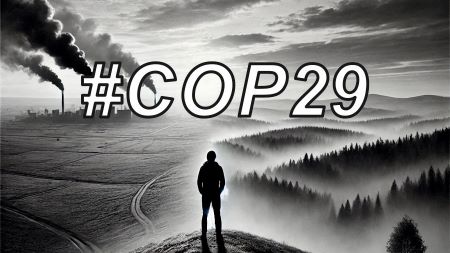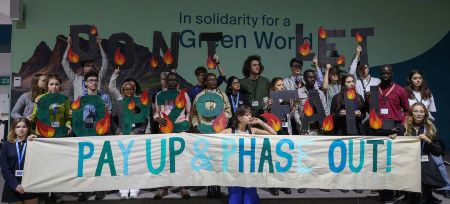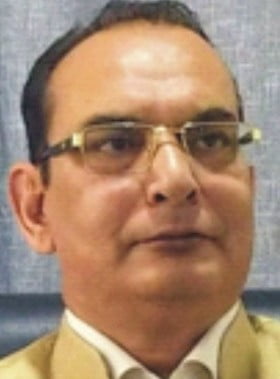Amidst Geopolitical Tensions and Financial Hurdles, the Global Climate Summit in Baku Struggles to Forge a Path Forward for a Sustainable Future
DELEGATES AT THE ongoing COP29 are expected to deliver new solutions to save the world from a climate catastrophe. However, instead of focusing solely on climate warriors, these expectations should pressure the developed world—often holding its purse strings tightly—to loosen them and finance what it has already damaged in its race for advancement through industrialization.
 Last week, the world’s biggest annual climate conference kicked off in Baku, Azerbaijan. This year’s UN climate summit is struggling to keep attention on the planet’s health, with turbulent geopolitics, a confrontational host, and the re-election of US climate skeptic Donald Trump stealing the spotlight.
Last week, the world’s biggest annual climate conference kicked off in Baku, Azerbaijan. This year’s UN climate summit is struggling to keep attention on the planet’s health, with turbulent geopolitics, a confrontational host, and the re-election of US climate skeptic Donald Trump stealing the spotlight.
The annual conference, aimed at producing global agreements to limit warming and avert climate catastrophe, is becoming a forum of frustration for negotiators seeking a financial deal. Oil-producing Azerbaijan, the host of this year’s 29th Conference of the Parties (COP), has the limited goal of rallying countries around a target for annual financial aid to developing nations facing the escalating costs of climate change.
This mandate pales in comparison to next year’s agenda in Brazil’s Amazon rainforest, where governments will map out the course for the next decade. Yet, it remains crucial for many countries as a lead-up to Brazil’s COP30. Achieving this goal will require delicate diplomatic skills.
 The trickiest issue at COP29 is the “new collective quantified goal” (NCQG), a term that sounds more dignified than a “climate dereliction fund” to be financed by the developed world. The NCQG is set to replace the longstanding annual target of $100 billion in climate finance from richer to poorer countries. It is expected to be finalized by next year when all nations must declare their plans for reducing emissions over the next decade.
The trickiest issue at COP29 is the “new collective quantified goal” (NCQG), a term that sounds more dignified than a “climate dereliction fund” to be financed by the developed world. The NCQG is set to replace the longstanding annual target of $100 billion in climate finance from richer to poorer countries. It is expected to be finalized by next year when all nations must declare their plans for reducing emissions over the next decade.
According to a report in The Economist, in many developing countries, a little help from public financing can significantly lower borrowing costs and attract investors. Another challenging issue is how to distribute these funds. The Economist notes that bilateral deals between rich and developing countries could expose financing to geopolitical whims, making it difficult to track total commitments and potentially leading to waste. Rich countries may also seek returns on their investments by stipulating that funds be spent on their own equipment.
The report suggests that entrusting the World Bank with this mission would be wiser, though it would require a significant expansion—the recommended climate-finance pot from the ETC is about six times the Bank’s current annual disbursements. Additionally, geopolitical tensions complicate this task, particularly with China seeking more influence and America unwilling to relinquish its veto over the Bank’s decisions.
A report in Forbes argues that sticking with the status quo would be a wasted opportunity. Rich nations could achieve more significant emissions reductions globally by investing in the Global South.
 In concrete terms, COP29 is expected to build on the carbon market groundwork laid in previous COPs, aiming for a regulatory framework that ensures real, measurable emissions cuts. The International Institute for Sustainable Development emphasizes that clearer guidelines are crucial for a functional and fair carbon market. COP29 could be pivotal in determining whether carbon markets become a reliable tool for financing climate action or remain mired in regulatory uncertainty.
In concrete terms, COP29 is expected to build on the carbon market groundwork laid in previous COPs, aiming for a regulatory framework that ensures real, measurable emissions cuts. The International Institute for Sustainable Development emphasizes that clearer guidelines are crucial for a functional and fair carbon market. COP29 could be pivotal in determining whether carbon markets become a reliable tool for financing climate action or remain mired in regulatory uncertainty.
In outlining COP29 priorities, the United Nations highlighted the need to ensure vulnerable countries have timely access to resources. Climate-driven economic losses are estimated in the hundreds of billions annually. Without improved funding, vulnerable nations face severe financial strain. In Baku, discussions are expected to focus on establishing the fund’s governance structure, mobilizing resources, and scaling up the fund to bridge the gap between current pledges and actual needs. Progress on adaptation and loss-and-damage could provide life-changing support to millions, offering a crucial safety net as climate impacts intensify.
Meanwhile, India voiced significant concerns over the progress at COP29 so far. A Government of India statement declared, “We have seen no advancement on matters critical for developing countries. Our region is facing some of the worst climate impacts, with far less capacity to recover or adapt to the changes in the climate system for which we are not responsible.”
India emphasized that the Mitigation Ambition and Implementation Work Programme (MWP), established at Sharm El-Sheikh, should be implemented through focused exchanges of views, information, and ideas. The outcomes should be non-prescriptive, non-punitive, facilitative, and respectful of national sovereignty and circumstances, while acknowledging that contributions are nationally determined and will not impose new targets or goals. Frustrated by the developed countries’ reluctance to engage on these issues, India accused them of continuously shifting goalposts, delaying climate action, and consuming a disproportionately large share of the global carbon budget.

Cop29 Climate Summit
These solutions must integrate with broader climate policies, identifying areas where real action is needed. COP29 is likely to emphasize nature-positive initiatives, which support carbon sequestration and boost resilience to climate impacts like floods and droughts. According to the World Economic Forum, preserving nature is essential for maintaining the world’s carbon sinks, such as forests, which currently absorb about 7.6 billion metric tons of CO₂ annually. Scaling up nature-based solutions could help close the emissions gap and offer multiple benefits for ecosystems and biodiversity.
On November 12th, multilateral development banks, including the World Bank, committed to increasing climate finance to $120 billion by 2030, with $42 billion earmarked for adaptation. Any breakdown in talks over climate finance in Baku would represent a dereliction of duty by the developed world. It would also be a massive failure of imagination if delegates cannot agree on a workable formula at this year’s COP.
With accelerating climate impacts, COP29 is a critical opportunity for countries to act decisively. It is one of the last chances to limit global warming to avoid catastrophic consequences. From enhancing national commitments to refining carbon market structures, there is much work to be done. ![]()
Also Read: The Illusion of Indian Pride
Disclaimer : PunjabTodayNews.com and other platforms of the Punjab Today group strive to include views and opinions from across the entire spectrum, but by no means do we agree with everything we publish. Our efforts and editorial choices consistently underscore our authors’ right to the freedom of speech. However, it should be clear to all readers that individual authors are responsible for the information, ideas or opinions in their articles, and very often, these do not reflect the views of PunjabTodayNews.com or other platforms of the group. Punjab Today does not assume any responsibility or liability for the views of authors whose work appears here.
Punjab Today believes in serious, engaging, narrative journalism at a time when mainstream media houses seem to have given up on long-form writing and news television has blurred or altogether erased the lines between news and slapstick entertainment. We at Punjab Today believe that readers such as yourself appreciate cerebral journalism, and would like you to hold us against the best international industry standards. Brickbats are welcome even more than bouquets, though an occasional pat on the back is always encouraging. Good journalism can be a lifeline in these uncertain times worldwide. You can support us in myriad ways. To begin with, by spreading word about us and forwarding this reportage. Stay engaged.
— Team PT

